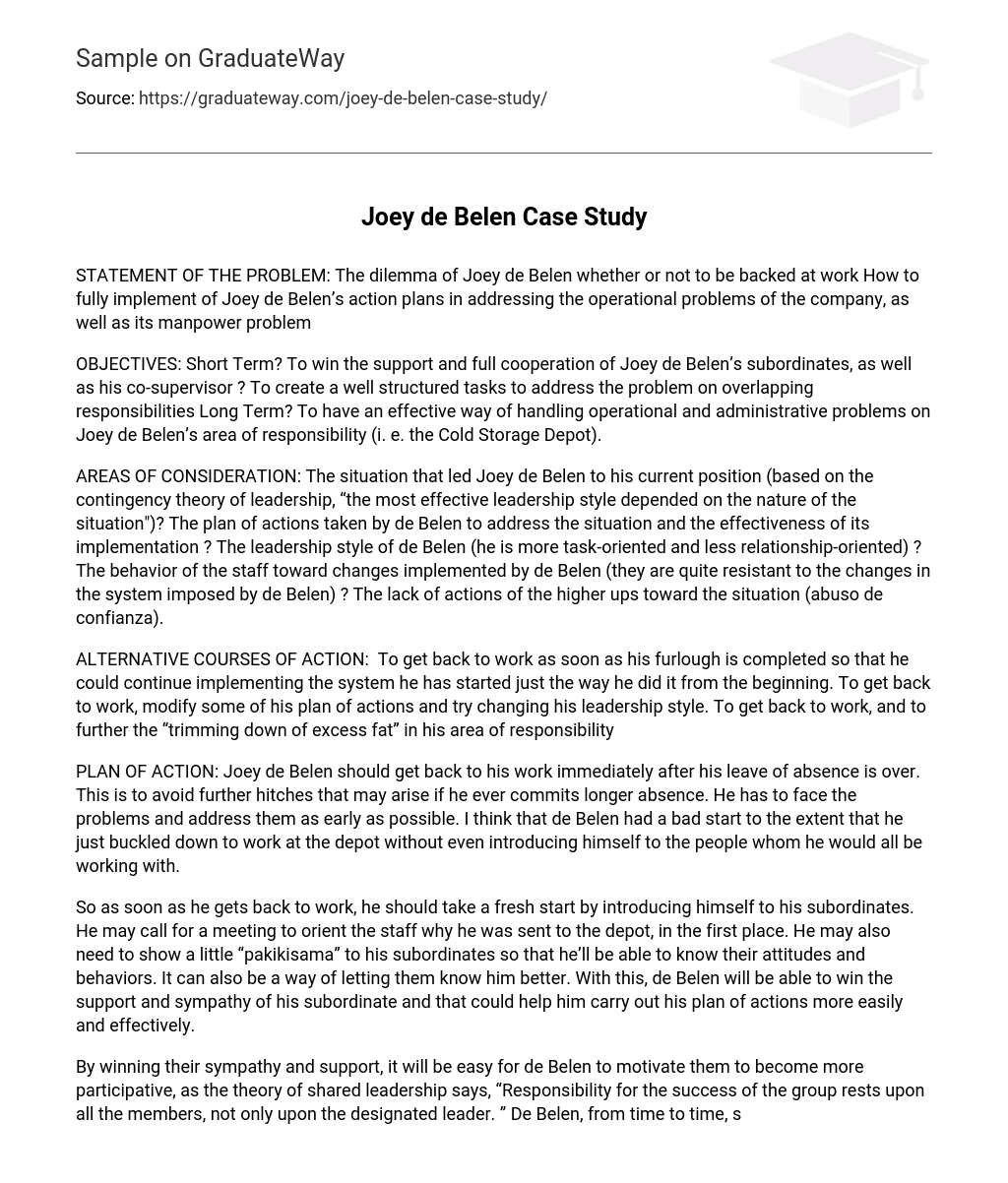The dilemma of Joey de Belen whether or not to be backed at work How to fully implement of Joey de Belen’s action plans in addressing the operational problems of the company, as well as its manpower problem
OBJECTIVES: Short Term? To win the support and full cooperation of Joey de Belen’s subordinates, as well as his co-supervisor ? To create a well structured tasks to address the problem on overlapping responsibilities Long Term? To have an effective way of handling operational and administrative problems on Joey de Belen’s area of responsibility (i. e. the Cold Storage Depot).
AREAS OF CONSIDERATION: The situation that led Joey de Belen to his current position (based on the contingency theory of leadership, “the most effective leadership style depended on the nature of the situation”)? The plan of actions taken by de Belen to address the situation and the effectiveness of its implementation ? The leadership style of de Belen (he is more task-oriented and less relationship-oriented) ? The behavior of the staff toward changes implemented by de Belen (they are quite resistant to the changes in the system imposed by de Belen) ? The lack of actions of the higher ups toward the situation (abuso de confianza).
ALTERNATIVE COURSES OF ACTION: To get back to work as soon as his furlough is completed so that he could continue implementing the system he has started just the way he did it from the beginning. To get back to work, modify some of his plan of actions and try changing his leadership style. To get back to work, and to further the “trimming down of excess fat” in his area of responsibility
PLAN OF ACTION: Joey de Belen should get back to his work immediately after his leave of absence is over. This is to avoid further hitches that may arise if he ever commits longer absence. He has to face the problems and address them as early as possible. I think that de Belen had a bad start to the extent that he just buckled down to work at the depot without even introducing himself to the people whom he would all be working with.
So as soon as he gets back to work, he should take a fresh start by introducing himself to his subordinates. He may call for a meeting to orient the staff why he was sent to the depot, in the first place. He may also need to show a little “pakikisama” to his subordinates so that he’ll be able to know their attitudes and behaviors. It can also be a way of letting them know him better. With this, de Belen will be able to win the support and sympathy of his subordinate and that could help him carry out his plan of actions more easily and effectively.
By winning their sympathy and support, it will be easy for de Belen to motivate them to become more participative, as the theory of shared leadership says, “Responsibility for the success of the group rests upon all the members, not only upon the designated leader. ” De Belen, from time to time, should also use minimal threat to maintain superior-subordinate relationship. Minimal threat would serve as reminder that he has the authority over the operation of the division. This is important to avoid abuses by the staff.
POTENTIAL PROBLEM ANALYSIS: “We cannot please everyone,” so a cliché goes. Even if de Belen would give is best to clean up the mess in the cold storage depot, he can’t still be assured to get 100% support from the staff. Some of them might think that the fresh start taken by de Belen is more of a “pakitang tao” rather than “pakikisama” and they will not be cooperative enough due to such malice. As to some who would give de Belen the chance of getting things refreshed, they might go beyond the limits of “pakikisama”. Because of being close to their superior, they might be oblivious of the boundaries of their relationship with de Belen. With the shared leadership, some of them might think about themselves parallel to their designated leader.
Thus, abuses may arise. Another potential problem that I can see coming is the tendency of the staff to be “ningas cogon”. They may be good at the start but later on, when they feel that their action isn’t paying off, they may cease acting such way. Thus, the old practices may come back.
FALL BACK POSITION: When everything has been faithfully done (systems been updated to improve the operations of the division) yet still the same old scenarios manifest in the depot, the action that I wish to be pursued is to “trim down excess fat” in Joey de Belen’s area of responsibility.
This means, mass lay off. There’s no any good reason to keep unproductive employees in the company. It would be better if de Belen, with the approval of the top management and following due process, shall dismiss some of the idle staff and retain those who are productive. Why pay 40 employees (where some are unproductive), when the same specifications of job can be handled effectively and efficiently by 20 employees. By terminating unproductive staff, the remaining staff may be hired fulltime again.
This is a good offset of quality with quantity. I don’t consider resigning as a good option to address this problem but if the higher management itself would not take active part in coming up with any solution, Joey de Belen’s last resort is to show himself a door to a greener pasture. Brilliant and young at 24, he has for sure a lot of better opportunity waiting out in the cold. Is it the system or the people that we need to change?





